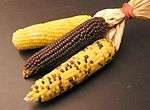Maize streak virus
| Maize streak virus | |
|---|---|
| Common names | MSV, streak of maize |
| Causal agents | Maize streak virus |
| Hosts | maize, Urochloa panicoides |
| Vectors | leafhoppers (Cicadulina mbila, and other Cicadulina species, such as C. storeyi, C. arachidis and C. dabrowski) |
| EPPO code | MSV000 |
| Distribution | sub-Saharan Africa |
| Maize streak virus | |
|---|---|
| Virus classification | |
| Group: | Group II (ssDNA) |
| Order: | Unassigned |
| Family: | Geminiviridae |
| Genus: | Mastrevirus |
| Species: | Maize streak virus |
Maize streak virus causes a plant disease, known as maize streak disease (MSD) in its major host. It is an insect-transmitted maize pathogen in the genus Mastrevirus of the family Geminiviridae that is endemic in sub-Saharan Africa and neighbouring Indian Ocean island territories such as Madagascar, Mauritius and La Reunion. The A-strain of MSV (MSV-A) causes sporadic maize streak disease epidemics throughout the maize growing regions of Africa.[1][2][3] MSV was first described by the South African entomologist Claude Fuller who referred to it in a 1901 report as “mealie variegation”.[4]
The development of conventionally resistant maize varieties has been a priority since the 1950s in Kenya, Nigeria, South Africa and elsewhere, with a good deal of success: however, there are several genes associated with resistance, and breeding is complex. Transgenically resistant or genetically modified maize varieties were under development in South Africa,[5] but the project has terminated without field trials of the candidate maize lines that were developed.
MSV is mainly transmitted by Cicadulina mbila Naude, but other leafhopper species, such as C. storeyi, C. arachidis and C. dabrowski, are also able to transmit the virus.
Typical of all mastreviruses, MSV's circular, ~2.7-Kb monopartite single-stranded (ss) DNA genome encodes only four proteins. Bidirectional transcription from a long intergenic region (LIR) results in the virion-sense expression of a movement protein (MP) and a coat protein (CP), and the complementary-sense expression of the replication-associated proteins, Rep and RepA. Whereas the MP and CP are involved in virus movement and encapsidation,[6] Rep is an essential initiator of virus replication, and RepA is a regulator of host and viral gene transcription.[7][8][9][10] Due to genome size restrictions, MSV usurps host DNA replication and double-stranded DNA break repair proteins to replicate its genome via, respectively, rolling-circle [11] and recombination-dependent mechanisms.[12]
References
- ↑ Dionne N Shepherd, Darren P Martin, Eric Van Der Walt, Kyle Dent, Arvind Varsani, Ed Rybicki (2009), "Maize streak virus: an old and complex 'emerging' pathogen", Molecular Plant Pathology, 11: 1–12, doi:10.1111/j.1364-3703.2009.00568.x
- ↑ Darren P. Martin & Dionne N. Shepherd (2009), "The epidemiology, economic impact and control of maize streak disease", Food Security, 1: 305–315, doi:10.1007/s12571-009-0023-1
- ↑ Nilsa A. Bosque-Pérez (2000), "Eight decades of maize streak virus research", Virus Research, 71: 107–121, doi:10.1016/S0168-1702(00)00192-1
- ↑ McAlister, A. (27 October 2010). "South Africa at front line of GM research". Media Club South Africa. Retrieved 21 October 2011.
- ↑ Dionne N. Shepherd; Tichaona Mangwende; Darren P. Martin; Marion Bezuidenhout; Frederik J. Kloppers; Charlene H. Carolissen; Adérito L. Monjane; Edward P. Rybicki & Jennifer A. Thomson (2007), "Maize streak virus-resistant transgenic maize: a first for Africa", Plant Biotechnology Journal, 5: 759–767, doi:10.1111/j.1467-7652.2007.00279.x, PMID 17924935
- ↑ Sondra G. Lazarowitz; Allison J. Pinder; Vernon D. Damsteegt & Stephen G. Rogers (1989), "Maize streak virus genes essential for systemic spread and symptom development", EMBO J, 8: 1023–1032, PMC 400910

- ↑ Xiangcan Zhan, Kim A. Richardson, Ann Haley and Bret A. M. Morris (1993), "The Activity of the Coat Protein Promoter of Chloris Striate Mosaic Virus Is Enhanced by Its Own and C1-C2 Gene Products", Virology, 193: 498–502, doi:10.1006/viro.1993.1153, PMID 8438584
- ↑ JMI Hofer, EL Dekker, HV Reynolds, CJ Woolston, BS Cox and PM Mullineaux (1992), "Coordinate Regulation of Replication and Virion Sense Gene Expression in Wheat Dwarf Virus", The Plant Cell, 4: 213–223, doi:10.2307/3869574, PMC 160122
 , PMID 1633494
, PMID 1633494 - ↑ Kathleen L. Hefferon; Yong-Sun Moon; Ying Fan (2006), "Multi-tasking of nonstructural gene products is required for bean yellow dwarf geminivirus transcriptional regulation", The FEBS Journal, 273: 4482–4494, doi:10.1111/j.1742-4658.2006.05454.x, PMID 16972938
- ↑ S Collin; M Fernández-Lobato; P S Gooding; P M Mullineaux & C Fenoll (1996), "The two nonstructural proteins from wheat dwarf virus involved in viral gene expression and replication are retinoblastoma-binding proteins", Virology, 219: 324–329, doi:10.1006/viro.1996.0256, PMID 8623550
- ↑ Keith Saunders, Andrew Lucy & John Stanley (1991), "DNA forms of the geminivirus African cassava mosaic virus consistent with a rolling circle mechanism of replication", Nucleic Acids Research, 19: 2325–2330, doi:10.1093/nar/19.9.2325, PMC 329438
 , PMID 2041773
, PMID 2041773 - ↑ Julia B. Erdmann; Dionne N. Shepherd; Darren P. Martin; Arvind Varsani; Edward P. Rybicki & Holger Jeske (2010), "Replicative intermediates of maize streak virus found during leaf development.", Journal of General Virology, 91: 1077–1081, doi:10.1099/vir.0.017574-0, PMID 20032206
